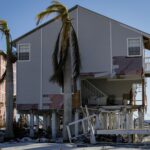More people are building homes in hazardous fire areas of the Sierra Nevada — increasing firefighting costs, according to a two-year study released by a conservation group. The Sierra Nevada is primarily in eastern California and extends into neighboring Nevada.
The 45-page report by the Sierra Nevada Alliance found that more than 88,000 people settled in the Sierra’s extreme or very high fire-threat areas between 1990 and 2000 — an increase of 16 percent.
California firefighting spending increased 10 percent between 1994 and 2004 due, in part, to the need to protect homes in wildland areas, the report said.
“There is a tremendous amount of population growth going on in these extreme fire danger areas,” said Autumn Bernstein, the group’s land use coordinator and the report’s author. “Unless Sierra counties can start to change the way they are growing, we are going to have a much bigger fire problem on our hands.”
The growth in the state’s third-fastest growing region doesn’t appear to be slowing down. The Sierra Nevada region is expected to triple in population by 2040 to 1.5 million residents. About 94 percent of the planned new home development is located in the so-called danger zones, according to the report.
Larry Lohman, the deputy director in El Dorado County’s Development Services Department, said fire safety is a consideration in all new developments.
“The state requires that counties adopt fire safety regulations,” Lohman said. “I think there’s quite a bit of review at both the subdivision level and the building level.”
In Nevada, the number of homes built in wildfire-prone areas doubled from 1990 to 2000 to 466,500 houses. The 92 percent increase was higher than anywhere in the nation. No recent figures were available.
“Every day, we are building new houses in extremely dangerous parts of the Sierra,” said Kay Ogden, Sierra Nevada Alliance development director. “This should be a wake-up call that destructive wildfires like the recent Angora Fire in Lake Tahoe and the Hawken Fire in Reno will become more common, unless we all start working together to make better decisions on how western Nevada and the Sierra grow.”
Officials expect the Sierra to become hotter and drier. And as more people move into the forest and accidentally set fires, the number of catastrophic fires will rise, creating “the perfect firestorm,” according to the report called “Dangerous Development: Wildfire and Rural Sprawl in the Sierra Nevada.”
To stop a future calamity, the alliance based in South Lake Tahoe is urging local governments to stop allowing land to be subdivided into ranchettes in forested areas and concentrate development in or near existing towns.
Landowners could be given density transfer rights that could be sold to developers, said Robert Johnston, an environmental policy professor at the University of California, Davis who lives in Truckee, Nev.
In July, elected officials on the Regional Planning Governing Board told developers of the Virginia 40s to provide plans on how to protect communities on steep mountain ridges above the southeast Truckee Meadows. The project would put 1,800 homes on 635 acres. The board rejected planning changes sought by property owners who wanted to develop homes on nearly half of 2,438 acres on the southern slopes of Peavine Peak.
For 119 acres across from the Reindeer Lodge high on the Mount Rose Highway, developer Tim Nelson is seeking changes to cluster development on half the property.
Fire spreads house to house, as when 254 homes burned in the first day of the Angora Fire near South Lake Tahoe, said Kurt Latipow, Washoe regional fire services coordinator.
Owners of ranchettes would have enough room to create defensible space around their homes, he said.
Latipow said part of the answer lies in adopting standards contained in the 2006 international wildland urban interface building code such as California is doing.
That would set construction types, protection measures, setbacks and clearances. It would also cover access and water supply issues. Homes should not be built on the edge of a ridge where fires can sneak up, said Ed Smith, University of Nevada Reno natural resource specialist with the Cooperative Extension Service in Reno.
He said new subdivisions in high-risk areas should have rules requiring low-risk vegetation and homeowners-association funds to maintain a community fire break if needed. Such a break stopped the recent Tahoe Donner Fire near Truckee.
Topics California Wildfire Homeowners Nevada
Was this article valuable?
Here are more articles you may enjoy.


 Vintage Ferrari Owners’ Favorite Mechanic Charged With Theft, Fraud
Vintage Ferrari Owners’ Favorite Mechanic Charged With Theft, Fraud  Florida’s Slide Insurance Secures $210 Million Catastrophe Bond
Florida’s Slide Insurance Secures $210 Million Catastrophe Bond  If US Inflation Reflected Rising Home Insurance Costs, It’d Be Even Higher
If US Inflation Reflected Rising Home Insurance Costs, It’d Be Even Higher  Former Maryland Insurance Agent Pleads Guilty to Stealing $369K
Former Maryland Insurance Agent Pleads Guilty to Stealing $369K 

